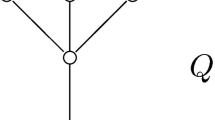Abstract
We give a lattice theoretic proof of the well-known result that a finite group G is cyclic iff G has at most one subgroup of each order dividing |G|. Consequently, we show that a division ring D is a field iff D has at most one maximal subfield.


Similar content being viewed by others
Explore related subjects
Discover the latest articles, news and stories from top researchers in related subjects.Notes
Note that the idea is closely related to with Frobenius conjecture on characteristic subgroup of finite group.
References
Birkhoff G (1964) Lattice theory, Rev edn. AMS, Colloquium Publications, New York
Burris S, Sankappanavar HP (1981) A course in universal algebra, (GTM). Springer, London
Lam TY (1991) A first course in noncommutative rings. Springer, London
Ogus A (2008) Math 113—Introduction to Abstract Algebra, Cyclicity of Groups, Cyclicty. Available from http://math.berkeley.edu/~ogus/Math_113_08/supplements/cyclicity
Author information
Authors and Affiliations
Corresponding author
Ethics declarations
Conflict of interest
The authors declare that they have no conflict of interest.
Additional information
Communicated by Y. Yang.
The work is partially supported by NSFC (Grant 11271040), and the Fundamental Research Funds for the Central Universities (Grant 302996).
Rights and permissions
About this article
Cite this article
Chen, Y., Yang, Y. An application of subgroup lattices. Soft Comput 21, 2503–2505 (2017). https://doi.org/10.1007/s00500-017-2571-1
Published:
Issue Date:
DOI: https://doi.org/10.1007/s00500-017-2571-1



